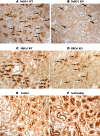Effect of NBCe1 deletion on renal citrate and 2-oxoglutarate handling
- PMID: 27117802
- PMCID: PMC4848728
- DOI: 10.14814/phy2.12778
Effect of NBCe1 deletion on renal citrate and 2-oxoglutarate handling
Abstract
The bicarbonate transporter, NBCe1 (SLC4A4), is necessary for at least two components of the proximal tubule contribution to acid-base homeostasis, filtered bicarbonate reabsorption, and ammonia metabolism. This study's purpose was to determine NBCe1's role in a third component of acid-base homeostasis, organic anion metabolism, by studying mice with NBCe1 deletion. Because NBCe1 deletion causes metabolic acidosis, we also examined acid-loaded wild-type adult mice to determine if the effects of NBCe1 deletion were specific to NBCe1 deletion or were a non-specific effect of the associated metabolic acidosis. Both NBCe1 KO and acid-loading decreased citrate excretion, but in contrast to metabolic acidosis alone, NBCe1 KO decreased expression of the apical citrate transporter, NaDC-1. Thus, NBCe1 expression is necessary for normal NaDC-1 expression, and NBCe1 deletion induces a novel citrate reabsorptive pathway. Second, NBCe1 KO increased 2-oxoglutarate excretion. This could not be attributed to the metabolic acidosis as experimental acidosis decreased excretion. Increased 2-oxoglutarate excretion could not be explained by changes in plasma 2-oxoglutarate levels, the glutaminase I or the glutaminase II generation pathways, 2-oxoglutarate metabolism, its putative apical 2-oxoglutarate transporter, OAT10, or its basolateral transporter, NaDC-3.
In summary: (1) NBCe1 is necessary for normal proximal tubule NaDC-1 expression; (2) NBCe1 deletion results in stimulation of a novel citrate reabsorptive pathway; and (3) NBCe1 is necessary for normal 2-oxoglutarate metabolism through mechanisms independent of expression of known transport and metabolic pathways.
Keywords: 2‐oxoglutarate; NBCe1; NaDC‐1; acidosis; citrate; proximal tubule.
© 2016 The Authors. Physiological Reports published by Wiley Periodicals, Inc. on behalf of the American Physiological Society and The Physiological Society.
Figures








Similar articles
-
Acid-base effects of combined renal deletion of NBCe1-A and NBCe1-B.Am J Physiol Renal Physiol. 2022 Feb 1;322(2):F208-F224. doi: 10.1152/ajprenal.00358.2021. Epub 2022 Jan 10. Am J Physiol Renal Physiol. 2022. PMID: 35001662 Free PMC article.
-
NBCe1-A Regulates Proximal Tubule Ammonia Metabolism under Basal Conditions and in Response to Metabolic Acidosis.J Am Soc Nephrol. 2018 Apr;29(4):1182-1197. doi: 10.1681/ASN.2017080935. Epub 2018 Feb 26. J Am Soc Nephrol. 2018. PMID: 29483156 Free PMC article.
-
NBCe1 expression is required for normal renal ammonia metabolism.Am J Physiol Renal Physiol. 2015 Oct 1;309(7):F658-66. doi: 10.1152/ajprenal.00219.2015. Epub 2015 Jul 29. Am J Physiol Renal Physiol. 2015. PMID: 26224717 Free PMC article.
-
Structure, function, and regulation of the SLC4 NBCe1 transporter and its role in causing proximal renal tubular acidosis.Curr Opin Nephrol Hypertens. 2013 Sep;22(5):572-83. doi: 10.1097/MNH.0b013e328363ff43. Curr Opin Nephrol Hypertens. 2013. PMID: 23917030 Free PMC article. Review.
-
[Physiology and pathophysiology of Na⁺/HCO₃⁻ cotransporter NBCe1].Sheng Li Xue Bao. 2012 Dec 25;64(6):729-40. Sheng Li Xue Bao. 2012. PMID: 23258339 Review. Chinese.
Cited by
-
The proximal tubule through an NBCe1-dependent mechanism regulates collecting duct phenotypic and remodeling responses to acidosis.Am J Physiol Renal Physiol. 2023 Jan 1;324(1):F12-F29. doi: 10.1152/ajprenal.00175.2022. Epub 2022 Oct 20. Am J Physiol Renal Physiol. 2023. PMID: 36264886 Free PMC article.
-
Recent advances in understanding renal ammonia metabolism and transport.Curr Opin Nephrol Hypertens. 2016 Sep;25(5):436-43. doi: 10.1097/MNH.0000000000000255. Curr Opin Nephrol Hypertens. 2016. PMID: 27367914 Free PMC article. Review.
-
Acid-base effects of combined renal deletion of NBCe1-A and NBCe1-B.Am J Physiol Renal Physiol. 2022 Feb 1;322(2):F208-F224. doi: 10.1152/ajprenal.00358.2021. Epub 2022 Jan 10. Am J Physiol Renal Physiol. 2022. PMID: 35001662 Free PMC article.
-
Expression of sodium-dependent dicarboxylate transporter 1 (NaDC1/SLC13A2) in normal and neoplastic human kidney.Am J Physiol Renal Physiol. 2017 Mar 1;312(3):F427-F435. doi: 10.1152/ajprenal.00559.2016. Epub 2016 Dec 7. Am J Physiol Renal Physiol. 2017. PMID: 27927654 Free PMC article.
-
Regulation of renal NaDC1 expression and citrate excretion by NBCe1-A.Am J Physiol Renal Physiol. 2019 Aug 1;317(2):F489-F501. doi: 10.1152/ajprenal.00015.2019. Epub 2019 Jun 12. Am J Physiol Renal Physiol. 2019. PMID: 31188034 Free PMC article.
References
-
- Aalkjaer, C. , Frische S., Leipziger J., Nielsen S., and Praetorius J.. 2004. Sodium coupled bicarbonate transporters in the kidney, an update. Acta Physiol. Scand. 181:505–512. - PubMed
-
- Aruga, S. , Wehrli S., Kaissling B., Moe O. W., Preisig P. A., Pajor A. M., et al. 2000. Chronic metabolic acidosis increases NaDC‐1 mRNA and protein abundance in rat kidney. Kidney Int. 58:206–215. - PubMed
-
- Bahn, A. , Hagos Y., Reuter S., Balen D., Brzica H., Krick W., et al. 2008. Identification of a new urate and high affinity nicotinate transporter, hOAT10 (SLC22A13). J. Biol. Chem. 283:16332–16341. - PubMed
-
- Bai, X. , Chen X., Feng Z., Hou K., Zhang P., Fu B., et al. 2006. Identification of basolateral membrane targeting signal of human sodium‐dependent dicarboxylate transporter 3. J. Cell. Physiol. 206:821–830. - PubMed
Publication types
MeSH terms
Substances
Grants and funding
LinkOut - more resources
Full Text Sources
Other Literature Sources
Molecular Biology Databases
Research Materials

